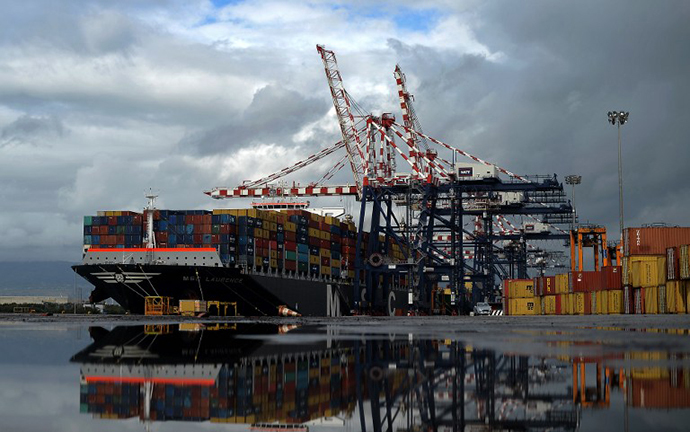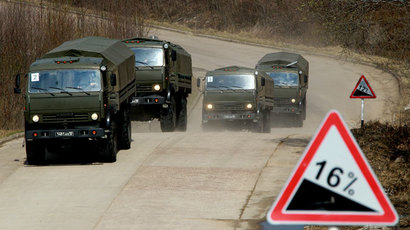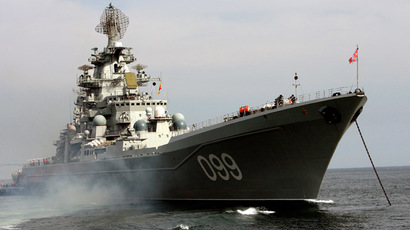Syria to ship out ‘most dangerous’ chemical weapons by March
As a third batch of Syria’s chemical weapons leaves for Italy, Assad’s envoy to Russia says the most dangerous chemicals will leave the country by the end of February. The US hopes to destroy Assad’s chemical weapons stockpile in a single operation.
The Organization for the Prohibition of Chemical Weapons (OPCW) confirmed Monday that another lot of Syria’s dangerous chemical materials has been transferred to a Norwegian cargo vessel, which is now on its way to the Italian port of Gioia Tauro in Calabria, one of Europe's largest shipping ports.
The extrication of chemical weapons and dangerous materials from war-torn Syria was supposed to be completed by February 5, and is falling behind schedule.
Syrian authorities blame the unstable situation in the country, riven by civil war, as the evacuation of weapons of mass destruction is being carried out under fire from Islamists rebels in the country.
“Most of the chemical weapons stockpiles, including the most toxic materials, will be evacuated from Syria by March 1,” Syria’s ambassador to Russia, Riad Haddad, told the Interfax news agency. “I believe we will meet the deadline," he said.
Impatience over the missed deadlines has been simmering in Washington, which is accusing Damascus of hindering the chemical disarmament.
On Monday, the Pentagon announced that US ship MV Cape Ray, which left Portsmouth on January 27 and is currently headed for the Mediterranean on a mission to destroy Syria’s chemical weapons, will make an indefinite stopover at a naval military base in Rota, Spain.

Since the chemical weapons and precursors were not handed over in time, the 135 US personnel aboard MV Cape Ray will have to wait until all Syria’s chemical WMD are brought to Italy. Otherwise the ship would have to shuttle between port Gioia Tauro and the sea area designated for weapons destruction for every new batch of chemical weapons.
“We expect [the MV Cape Ray] to remain in Rota until such time as she’s prepared to transload all of the Syrian chemical weapons [and chemical materials] that she is slated to destroy,” Pentagon spokesman Col. Steve Warren told reporters.
The Cape Ray is expected to reach Rota later this week, Warren said.
According to interstate agreements, Syrian authorities are responsible for collecting all of their chemical weapons and dangerous materials from 12 sites and bringing them to the port of Latakia, using a total of 75 armored combat vehicles provided by the Russian government. The materials are packed in US-provided container drums, and all transportations are monitored with GPS locators and cameras.
Russia is ensuring the security of the port of Latakia and supervising loading operations. Then cargo ships provided by Denmark and Norway are escorted by Chinese, Danish, Norwegian and Russian warships to Italy’s Gioia Tauro port for consolidation of the materials.

The last stage of the elimination of Syria’s chemical weapons will take place aboard the US Maritime Administration cargo ship MV Cape Ray, where the weapons will be neutralized offshore in the central Mediterranean with the use of a Field Deployable Hydrolysis System.
Some chemical materials suitable for making WMD, including 93 percent of Isopropanol, the key component of the toxic gas sarin, have already been destroyed within Syria, OPCW Director-General Ahmet Uzumcu reported. The rest will be shipped outside the country for utilization at commercial facilities.
Syria has already missed several deadlines in the chemical weapons elimination schedule, starting to remove the dangerous chemicals on January 7, a week later than promised, and missing the February 5 deadline for collecting all of the material.
"We have to remember that Syria is a country at war. The security situation can shift from day to day," said Sigrid Kaag, special coordinator of the Joint OPCW Mission at the UN.
The government of President Bashar Assad has insisted that Syria will not miss the final deadline and will have its chemical WMD arsenals destroyed by June 30.














